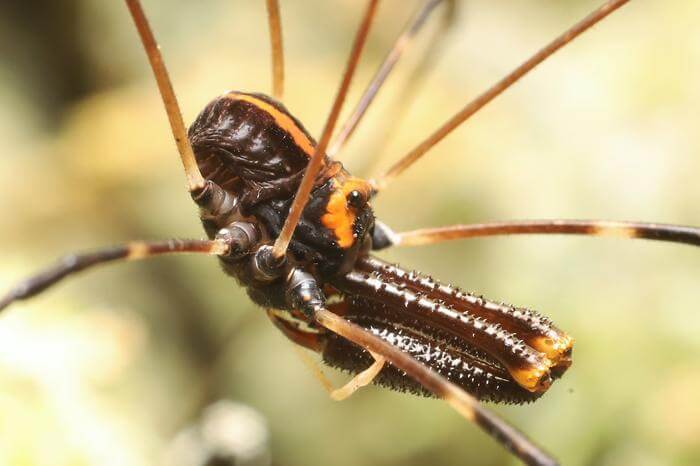- Harvestmen, a type of long-legged arachnids, exhibit three types of males, each with different body sizes and behaviors.
- Alpha and beta males are large and use their oversized jaws as weapons to fight for females, while gamma males are smaller and seek to mate sneakily with undefended females.
- Research suggests that males which lost at least one leg during their development are more likely to become gamma males, possibly due to limited food intake or a disadvantage in fighting.
Long-legged arachnids called harvestmen are “trimorphic,” featuring three types of males. University of Auckland research is giving some clues as to how that happens.
A male sexual hierarchy and the oversized “weaponry” of the alpha and beta males are features of New Zealand’s Forsteropsalis pureora species which lives in wet native forests and caves.
Now, research by Waipapa Taumata Rau, University of Auckland graduate Dr Erin Powell, completed for her PhD, has revealed clues as to why some males fall to the bottom of the hierarchy.
Females are of one type, but males are of three types, each with a different body size and shape. Alpha and beta males are large and use their big, protruding chelicerae (jaws) – which may account for as much as 50 percent of their body weight – as weapons to fight each other for females. Gamma males are up to seven times smaller and, instead of fighting, search for undefended females to sneakily mate with.
The creatures can shed legs to escape predators, like lizards detaching their tails, but never grow new ones.
Scars indicate if a harvestman lost a leg as a juvenile or an adult. Males which lost at least one leg during their development were 45 times more likely to grow up to be the smaller, weaker, gamma males, according to research led by Powell, published in the academic journal Behavioral Ecology.
“Perhaps this is because they can’t get enough food for their development because their hunting is impeded,” says Powell, now a research scientist for the Florida Department of Agriculture and Consumer Services.
“Or maybe there’s no point in investing in big fighting weapons when they’re already disadvantaged when it comes to fighting,” she says. “So, the arachnids’ resources may be invested in other things, such as testes size, sperm count, or aerobic poise, to ensure they make the most of the mating opportunities they get.”
Adopting a new strategy, such as scrambling to find undefended females, is better than trying and failing in traditional, potentially dangerous, male-male contests, she says.
Trimorphism, or having three forms, is uncommon in the animal kingdom. So far, researchers think a combination of genetics and nutrition may drive so much variation within a single species.
This study showed that environmental factors, like experience with predators, may be more important than previously considered in determining the final adult form of males.
There are still many questions as to why alphas and betas evolved, both with big bodies and big weaponry, but with different shaped weapons. Perhaps each has its advantages in fights, one with more power but the other with more reach in the tangled scuffles of limbs and claws?
“With their ridiculous towering weaponry and extreme male size variation, New Zealand harvestmen are both charming and puzzling,” says Powell. “We still have much to learn about their fascinating biology and they have much to teach us about the evolution of mating systems across animal taxa.”
More closely related to scorpions than spiders, harvestmen are harmless critters without venom or silk and New Zealand has many native species of them.
Recap
University of Auckland research on harvestmen, a type of arachnid, has revealed insights into the different male types within the species. The study found that males which lost legs during development were more likely to become smaller gamma males, suggesting that environmental factors and experiences with predators may influence the final adult form of males. The findings shed light on the unique biology of harvestmen and the evolution of mating systems in animals.


